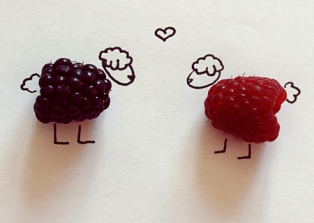 Kindermusik has over 5000 super-talented, super-dedicated Kindermusik educators around the globe. But at Kindermusik International, or (to use a term we never use) “Corporate Headquarters,” we’re a small, tight-knit group of employee-owners – KI is 100% employee owned. KI is a second family to many of the folks who work here. So when someone leaves, it’s always a very sad event.
Kindermusik has over 5000 super-talented, super-dedicated Kindermusik educators around the globe. But at Kindermusik International, or (to use a term we never use) “Corporate Headquarters,” we’re a small, tight-knit group of employee-owners – KI is 100% employee owned. KI is a second family to many of the folks who work here. So when someone leaves, it’s always a very sad event.
Last year one of our favorites, Lisa Rowell, left the ranks and moved to Atlanta with her husband and two girls. Lisa, Ellery, and Emmy are pictured to the right, enjoying the oh-so-common Atlanta snow (it sure has been a strange winter in many places). While at KI, Lisa worked in marketing and, as anyone who knows her would agree, was one of the most funny, smart, silly, and engaging people you could hope to share an office space or conference call with.
We all hated to see Lisa go.
So we were delighted when we recently learned Lisa was still part of the Kindermusik family, although in a slightly different way. Below is a note she sent to our CEO, Michael Dougherty. With Lisa’s permission, we’d like to share it here. It was so nice for us to hear from Lisa, and the note also touches on so many of the fantastic aspects of Kindermusik – the sense of community, the time spent focused on family (both in the classroom and at home), the head start on learning, and of course the unbridled fun!
Thanks, Lisa, for keeping in touch and for being part of the Kindermusik family.
March 2, 2010
Michael,
Thank you.
Those two words are not written as a former Employee-Owner, although they certainly could be. During my seven-year tenure, I experienced a remarkable culture composed of talented, driven, and focused individuals, who made the decision to bring music into the lives of thousands of families.
Instead, these words are written as a Kindermusik parent. It has taken me 13 months to write this letter, because frankly, it took me that long to be “just a parent” in the classroom. I am no longer privy to strategy and budgets and marketing campaigns. The daily challenges and opportunities of being an Employee-Owner finally feel more distant than present. Now when I enter the classroom, I no longer think of it as market research or worry that my daughters won’t act “Kindermusik enough” for the other parents. Instead, I enter the classroom as just Emerson’s and Ellery’s mom.
In the fall, we took a Kindermusik hiatus, partly so we could settle into our new community and partly because the closest Kindermusik educator just had a baby. However, like other parents in the Kindermusik bulls eye, Clay and I want the best for our girls so we enrolled in Jane Hendrix’s program in Dunwoody (Our Time and Imagine That!). It was like coming home.
Our Imagine That! class includes other Atlanta transplants, who like us, sought out the familiarity of Kindermusik. We meet at 12:30 on Wednesdays for lunch in the classroom before the class begins at 1pm. These parents and children bring with them the experiences of other Kindermusik educators. Educators from California, Texas, and even Australian are represented. This is the type of Imagine That! class that we dreamed about: parents, children, and educator forming connections with each other that extends well beyond the classroom.
The joy my daughters’ experience in the classroom and at home is unique to Kindermusik. Our daily lives are filled with hayrides, bumpy rides on red wagons, Johnny and Katie finger plays, family jams, imaginary trips to toy stores, multiple readings of Shiny Dinah or Noodles from Scratch, and even puppet shows courtesy of Wags, Hopper, and Rascal. There are moments when my extremely verbal four-year-old becomes so excited to be in Jane’s class that she loses her ability to speak clearly.
As an infant, “My Bonnie” from You Are My Sunshine calmed Ellery unlike any other song. This became the final song I sing to them at night. Initially a solo act, my voice is joined now by both my girls. To the outside listener, our voices sound more “Tarzan, Frankenstein, and Tonto” than “Emmy, Ellery, and Lisa” but to me it is pure beauty. This is a moment that only the heart will ultimately catalog.
Kindermusik helped create these moments in our family. Thank you, Michael. I know these words will not reach every person who contributed to the wonder of Kindermusik. Through the years, the names and faces change, but the mission remains the same: To put a song in the heart of every child.
Thank you, Kindermusik, for putting an entire symphony in the hearts of my girls.
Warmly,
Lisa Rowell
 Even before your baby is born, she responds to the sound of your voice. Researchers have observed that a baby in the womb can respond to the sound of a mother’s voice as early as 5 months into pregnancy.
Even before your baby is born, she responds to the sound of your voice. Researchers have observed that a baby in the womb can respond to the sound of a mother’s voice as early as 5 months into pregnancy.





 We've all seen energy build up in toddlers, preschoolers, or big kids. But you can usually redirect this energy with a fun little game. At the same time, you'll be helping to develop your child's physical control and something called "inhibitory control," or his or her ability to start and stop behaviors. Sometimes, all you need to do is turn on some music and play Freeze Dance!
We've all seen energy build up in toddlers, preschoolers, or big kids. But you can usually redirect this energy with a fun little game. At the same time, you'll be helping to develop your child's physical control and something called "inhibitory control," or his or her ability to start and stop behaviors. Sometimes, all you need to do is turn on some music and play Freeze Dance!  Bowling Green, KY, educator
Bowling Green, KY, educator  Kindermusik has over 5000 super-talented, super-dedicated Kindermusik educators around the globe. But at Kindermusik International, or (to use a term we never use) “Corporate Headquarters,” we’re a small, tight-knit group of employee-owners – KI is 100% employee owned. KI is a second family to many of the folks who work here. So when someone leaves, it’s always a very sad event.
Kindermusik has over 5000 super-talented, super-dedicated Kindermusik educators around the globe. But at Kindermusik International, or (to use a term we never use) “Corporate Headquarters,” we’re a small, tight-knit group of employee-owners – KI is 100% employee owned. KI is a second family to many of the folks who work here. So when someone leaves, it’s always a very sad event.  From the time your child wakes up in the morning to the time he or she goes to bed a night, sounds surround her: music, children at play, traffic, birds, TV, ticking clocks, and more. The ability to focus on one sound and distinguish it from background noise is different than simply hearing — that’s why listening is truly a learned skill.
From the time your child wakes up in the morning to the time he or she goes to bed a night, sounds surround her: music, children at play, traffic, birds, TV, ticking clocks, and more. The ability to focus on one sound and distinguish it from background noise is different than simply hearing — that’s why listening is truly a learned skill.  Babies and toddlers enjoy blowing. As they practice blowing, they strengthen mouth muscles and develop awareness of their breathing, which will help their language development.
Babies and toddlers enjoy blowing. As they practice blowing, they strengthen mouth muscles and develop awareness of their breathing, which will help their language development. One of our favorite things at Kindermusik International is when we are emailed stories from happy parents. These stories usually make us smile, not only because we get to see how the parents are enjoying their classes, but we know happy parents means happy Kindermusik educators too!
One of our favorite things at Kindermusik International is when we are emailed stories from happy parents. These stories usually make us smile, not only because we get to see how the parents are enjoying their classes, but we know happy parents means happy Kindermusik educators too!